Young black boys are suspended at disproportionate rates in school districts across Colorado. Some rural districts have the highest early childhood suspension rates in the state. And despite nationwide debate about the impact of harsh discipline on young children and local efforts to bring the numbers down, suspensions in the early grades are actually going up.
These are a few of the findings from a new Chalkbeat analysis of three years of data on out-of-school suspensions given to students in kindergarten through second grade. Chalkbeat obtained the district- and state level data — some of it disaggregated by race and gender — from the Colorado Department of Education through a public records request.
Last year, rural district leaders and the lawmakers who represent them beat back a bill that would have limited the use of suspensions in the earliest grades. This year, advocates decided not to bring forward a new version after struggling to find common ground with opponents. At the same time, at least three large metro Denver districts have recently launched their own efforts to reduce the number of small children sent home for misbehaving — but not without some trepidation from teachers.
Amidst these discussions, we wanted to know more about the early childhood discipline landscape in Colorado’s public schools.
Supporters of policies that limit suspensions of young children say such discipline doesn’t work to change students’ behavior, harms them educationally, and disproportionately affects boys and children of color. Opponents of such policies say suspension is a tool sometimes needed to help restore classroom order, ensure student and teacher safety, and focus a family’s attention on the problem.
Young children are suspended for a variety of reasons, including hitting, biting, fighting, and chronically disrupting their classrooms.
It’s important to note that we examined the number of suspensions given out in each district, not the total number of students who were suspended. In some cases, individual students receive multiple suspensions during a school year. (Suspension numbers are self-reported by each school district and not independently verified by the state.)
Colorado districts handed out more suspensions to young students last year than they did the year before (or the year before that).
Even as local and national groups have recently spotlighted the harm caused by suspending young children from schools, Colorado schools have handed out more suspensions.
Last year, districts statewide gave approximately three suspensions per 100 kindergarten to second grade students, up from 2.6 in 2014-15. The state education department first began disaggregating suspension data by grade level three years ago.
Three-year trends in Colorado’s K-2 suspension rates
This chart shows the number of suspensions given per 100 kindergarten through second grade students in rural districts, small rural districts and all Colorado districts over the last three years.
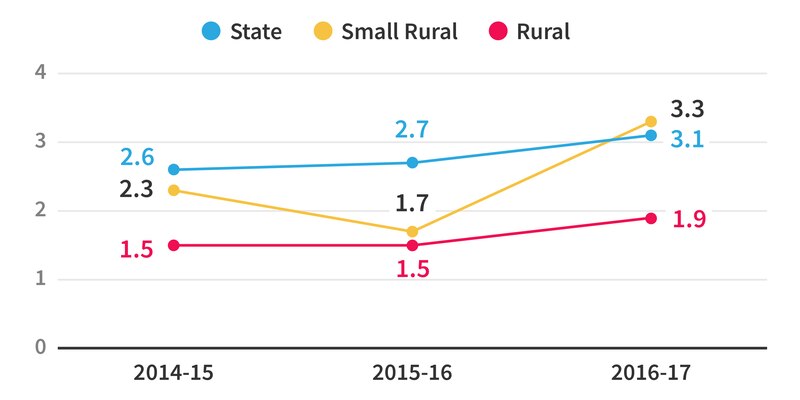
The highest-suspending districts are rural. (So are the lowest-suspending districts.)
Of the state’s more than 140 rural districts, several use suspensions in the early elementary grade at higher rates than any large district. For example, the 980-student Trinidad district in southern Colorado, posted the state’s highest rate last year, giving out 65 suspensions to students in kindergarten through second grade — a rate of 27 suspensions per 100 students.
Meanwhile, about 70 rural districts suspended no students at all last year. These include a few that are around the same size as Trinidad, including East Grand, Weld RE-9, and Telluride.
As a group, small rural districts — those with less than 1,000 students — are suspending early elementary children at about the same rate as non-rural districts — giving just over 3 suspensions per 100 students. Rural districts — somewhat bigger than “small rurals” but still under 6,500 students — suspend less frequently, giving out 2 suspensions per 100 students.
The state’s highest-suspending districts
A look at which rural school districts suspend young students at the highest rate. Rates reflect the number of suspensions given per 100 kindergarten through second grade students in 2016-17. Note: The state education department classifies Expeditionary BOCES as a “small rural” district, but it’s a single school located in Denver that pulls students from several area districts.
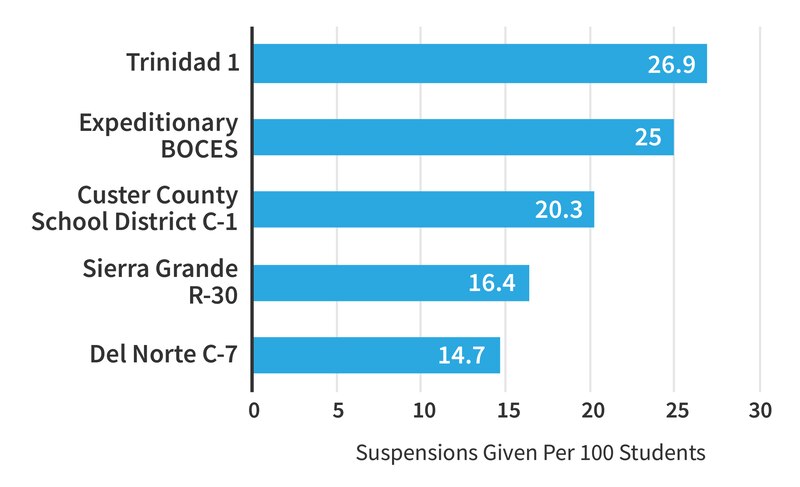
El Paso County is home to three of the five highest-suspending large districts.
Three of the large districts that used suspension in lower elementary grades most often last year are in El Paso County: Harrison, Colorado Springs and Widefield. One of the other two is in metro Denver and the other is in Greeley.
The three El Paso County districts have larger proportions of students from low-income families than some of their lower-suspending counterparts in that county — Falcon or Academy, for instance. However, other large districts, including Denver and Aurora, serve similar or greater proportions of students in poverty as the high-suspending El Paso County districts, yet have lower suspension rates.
Large districts with the highest suspension rates
This chart shows the five districts of Colorado’s 30 largest with the highest suspension rates in 2016-17. Rates reflect the number of suspensions given per 100 kindergarten through second grade students.
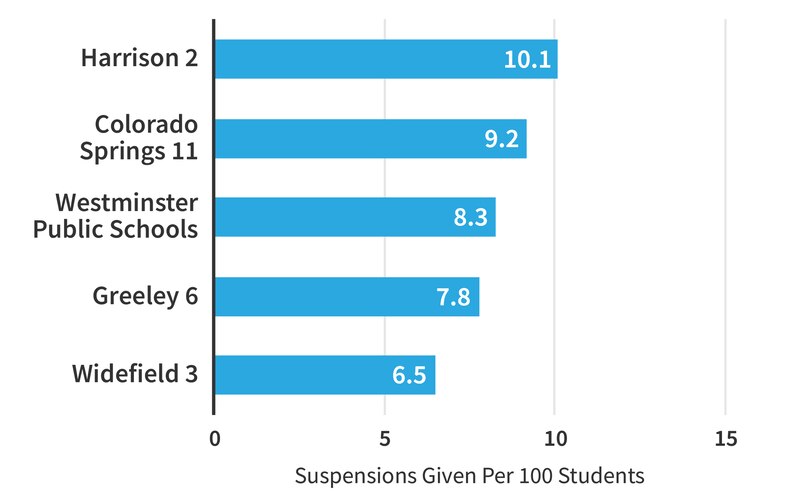
Large districts with the lowest suspension rates tend to be more affluent and white.
The five districts with the lowest suspension rates among the state’s 30 largest, are scattered geographically and range in size, but generally have fewer students from poor families and fewer students of color than high-suspending large districts.
One exception is the 7,000-student Eagle County district, which has the lowest suspension rate among the five. Students of color make up 55 percent of enrollment and 37 percent of students qualify for free or reduced-price meals, a proxy for poverty.
Large districts with the lowest suspension rates
This chart shows the five districts of Colorado’s 30 largest with the lowest suspension rates in 2016-17.
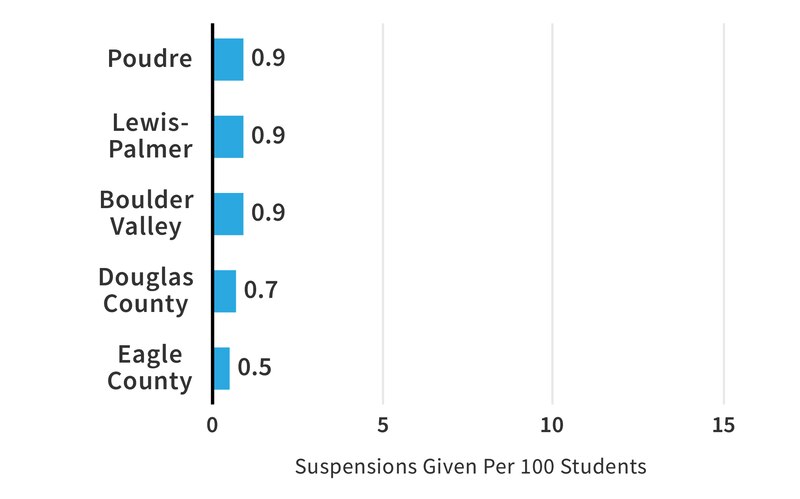
Suspension rates are dropping in Denver, and climbing in the state’s other four largest districts.
Of Colorado’s five largest districts, which educate about 75,000 students in kindergarten through second grade, Jeffco had the highest rate of early elementary suspensions last year, followed by Aurora. While the rates increased for both districts compared to the previous year, each has recently embarked on new efforts to prevent student suspensions.
Denver, which for years has emphasized restorative discipline practices and this year launched a policy limiting suspensions of preschool through third grade students, was the only one of the five largest districts to post a decrease in its early childhood suspension rate last year. Cherry Creek saw a jump last year, and Douglas County saw a smaller uptick.
Trends in Colorado’s five largest districts
A look at changing suspension rates in the state’s five largest districts over three years. Rates reflect the number of suspensions given per 100 kindergarten through second grade students.
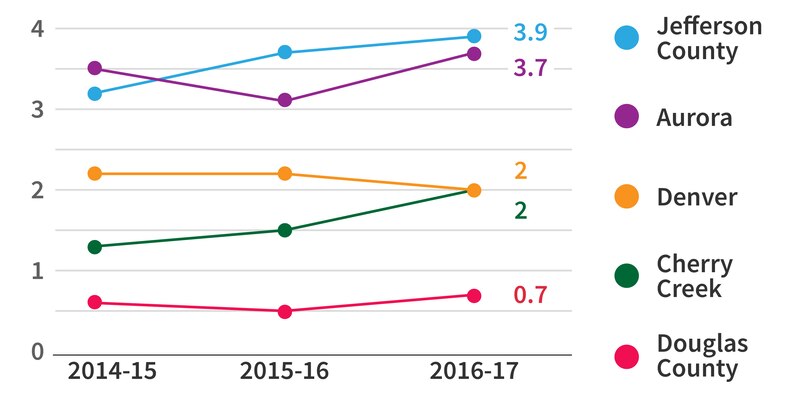
Young black boys are disproportionately suspended nationwide. Colorado is no exception.
While black boys make up up only about 2.3 percent of the state’s kindergarten to second grade students, they receive almost 10 percent of suspensions given in that age group. Such disparities exist in all 14 of the state’s 30 largest districts for which data was available.
The Denver district, which educates more young black students than any other in Colorado, was close behind the three districts with the highest levels of disproportionality. Last year, black boys made up about 6 percent of Denver’s kindergarten through second grade population, but received 29 percent of suspensions given in that age group.
(In 16 large districts, suspension data broken out for black male K-2 students was unavailable because privacy rules require some data to be suppressed when group sizes are very small.)
Disproportionate suspensions given to black boys
Among the state’s 30 largest districts, these three gave out a particularly disproportionate number of suspensions to black boys in kindergarten through second grade in 2016-17.
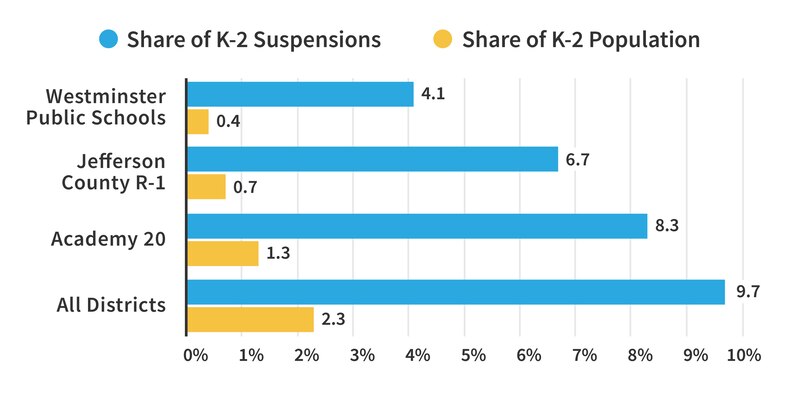
Young Hispanic boys receive a disproportionate number of suspensions in many Colorado districts — but not all.
At the state level, Hispanic boys make up 17 percent of the kindergarten through second grade population, but receive 29 percent of suspensions. At the district level, the picture varies. Seven of the state’s 30 large districts, including two with relatively high suspension rates overall, did not suspend a disproportionately large number of Hispanic boys last year. Those include Colorado Springs 11 and Harrison — the two highest suspending large districts — as well as Aurora, School District 27J, Fountain, Pueblo 70, and St. Vrain Valley.
In the 19 large districts that showed some disproportionality in suspending young Hispanic boys, the severity ranged widely. Two districts with very low overall suspension rates — Poudre and Douglas County — had high levels of disproportionality. In contrast, Falcon and Widefield had relatively low levels of disproportionality.
(In 4 of the 30 largest districts, suspension data broken out for Hispanic male K-2 students was unavailable because privacy rules require some data to be suppressed when group sizes are very small.)
Disproportionate suspensions given to Hispanic boys
Among the state’s 30 largest districts, these three gave out a particularly disproportionate number of suspensions to Hispanic boys in kindergarten through second grade in 2016-17.
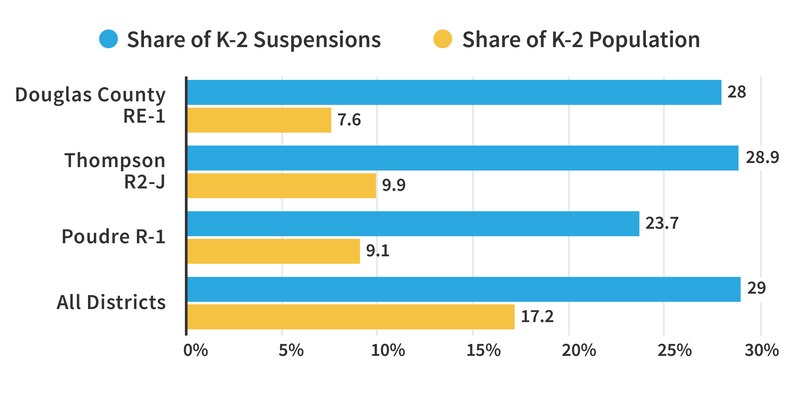
Look up your district’s 2016-17 K-2 suspension rate in the chart below.

